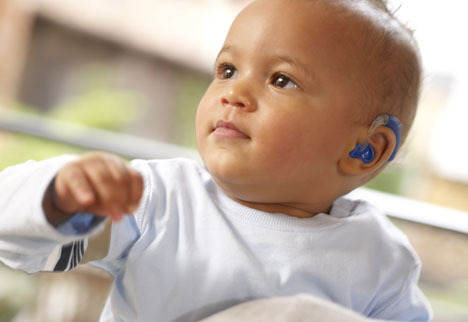-
 WHAT IS AUDITORY IMPAIRMENT? Auditory impairment is the partial or total inability to hear. Also known...
WHAT IS AUDITORY IMPAIRMENT? Auditory impairment is the partial or total inability to hear. Also known... -
 WHAT IS HEARING LOSS? In normal hearing, sound waves travel into the ear and cause the...
WHAT IS HEARING LOSS? In normal hearing, sound waves travel into the ear and cause the... -
 WHAT ARE THE BUILDING BLOCKS OF LANGUAGE? Understanding the building blocks of language can help prepare...
WHAT ARE THE BUILDING BLOCKS OF LANGUAGE? Understanding the building blocks of language can help prepare...

¿QUÉ ES LA PÉRDIDA DE AUDICIÓN?
En la audición normal, las ondas de sonido viajan hacia el oído y hacen que el tímpano vibre. La vibración ayuda a activar los nervios que envían información sonora al cerebro. Luego, el cerebro traduce estas ondas en sonido que una persona puede interpretar y comprender.
La pérdida auditiva ocurre cuando hay problemas en la parte estructural del oído, los nervios dentro del oído o la sección del cerebro que controla la audición. Hay tres tipos principales de pérdida auditiva:
- Conductiva : la pérdida auditiva conductiva es el resultado de una transmisión de sonido bloqueada en el oído. Ocurre con mayor frecuencia en bebés y niños pequeños debido a infecciones o líquido en el oído. Este tipo de pérdida auditiva suele ser leve, temporal y altamente tratable.
- Neurosensorial : la pérdida auditiva neurosensorial es el resultado de problemas estructurales en el oído y/o en los nervios que controlan la audición. Puede ser congénito (presente al nacer) u ocurrir más adelante en la vida. La pérdida auditiva neurosensorial suele ser permanente. Va desde leve ("dificultad para oír" algunos sonidos) hasta profundo (incapacidad para escuchar ningún sonido).
- Mixta : la pérdida auditiva mixta es un híbrido de pérdida auditiva conductiva y neurosensorial.
El Centro Warren ofrece una variedad de servicios de terapia para niños con discapacidad auditiva. Estos pueden incluir terapeutas del habla, especialistas individuales y grupos de apoyo. Para más información, contáctenos .
PRUEBAS DE AUDICIÓN
¿Cómo se prueba la audición?
Las pruebas de audición detectan signos de deterioro del audio en bebés, niños pequeños y niños pequeños. Estas pruebas son importantes ya que la audición juega un papel fundamental en el desarrollo del lenguaje hablado. Las pruebas de audición ayudan a identificar problemas para garantizar que su hijo reciba la ayuda adecuada para la pérdida de audición o los trastornos de comunicación relacionados.
¿Cuándo debe mi hijo hacerse una prueba de audición?
Los niños deben hacerse pruebas de audición de rutina durante los controles de salud. Los recién nacidos reciben pruebas de audición antes de salir del hospital. Si el bebé no pasa la prueba, los médicos suelen recomendar una nueva prueba dentro de los tres meses.
Los niños pequeños y los niños pequeños se someten a pruebas de audición que también pueden incluir controles de exceso de cerumen, líquido o infecciones. Algunos centros pediátricos utilizan sinónimos para pruebas de audición que incluyen exámenes de audiometría, pruebas de audiografía, pruebas de audiograma o pruebas de sonido.
La Academia Estadounidense de Pediatría recomienda que los niños siempre se sometan a un examen de audición completo a los 4, 5, 6, 8 y 10 años. También puede solicitar una prueba de audición si cree que su hijo muestra signos de pérdida auditiva.
¿Cuáles son los diferentes tipos de pruebas de audición?
La prueba de audición puede variar según la edad y los síntomas. Las pruebas para bebés y niños pequeños pueden incluir sondas que miden la audición y no necesitan una respuesta verbal. Los exámenes para niños mayores incluyen pruebas de sonido que requieren una respuesta a ruidos de diferente volumen y tono.
Hay dos tipos de profesionales autorizados para realizar pruebas y tratar la pérdida auditiva:
- Audiólogos: proveedores de atención médica capacitados para evaluar, diagnosticar, controlar y tratar la pérdida auditiva
- Otorrinolaringólogos (ENT): médicos que tratan problemas en los oídos, la nariz y la garganta
Algunas de las pruebas de audición más comunes incluyen las siguientes:
- Lluvia de ideas auditiva (ABR) : el ABR utiliza electrodos para evaluar la pérdida auditiva neurosensorial en recién nacidos y bebés.
- Emisiones otoacústicas (OAE) : la OAE utiliza sondas para verificar la pérdida auditiva general en bebés y niños pequeños.
- Timpanometría : una timpanometría verifica qué tan bien se mueve el tímpano. Dado que requiere que la persona se siente muy quieta, generalmente funciona mejor para niños mayores, preadolescentes y adolescentes.
- Medidas de reflejo acústico o reflejo muscular del oído medio (MEMR) : la prueba MEMR verifica qué tan bien responde el músculo del oído medio a los sonidos fuertes.
- Tono puro o audiometría : esta prueba determina los sonidos más bajos que una persona puede escuchar en diferentes niveles de tono.
- Diapasón : esta prueba utiliza un dispositivo metálico de dos puntas para determinar si hay pérdida auditiva conductiva o neurosensorial en uno o ambos oídos.
- Reconocimiento del habla y de las palabras : este examen evalúa qué tan bien su hijo puede escuchar y responder al lenguaje hablado.
SEÑALES DE PÉRDIDA DE AUDICIÓN
¿Cuáles son los signos de la pérdida auditiva?
Los signos de pérdida auditiva pueden variar ligeramente según el grupo de edad de su hijo.
Signos de pérdida auditiva en bebés:
- No muestra ninguna reacción a los ruidos fuertes
- No expresar ninguna reacción a la voz de los padres a los tres meses de edad
- No girar la cabeza hacia los sonidos a los seis meses de edad
- No imitar sonidos ni decir palabras básicas a los 12 meses de edad
Signos de pérdida auditiva en niños pequeños:
- Retraso en el habla que es difícil de entender (la mayoría de los niños pequeños dicen "papá" o "mamá" a los 15 meses de edad)
- Sin reacción o respuesta cuando se le llama por su nombre
- No prestar atención a la conversación o al ruido.
Signos de pérdida auditiva en niños mayores o adolescentes:
- Dificultad para escuchar a las personas en ambientes ruidosos
- Problemas para escuchar sonidos de tonos más altos
- Tener que subir siempre el volumen de la televisión
- Quejas de zumbidos en los oídos
¿QUÉ SIGNIFICAN LOS RESULTADOS?
¿Qué significan los resultados de las pruebas de audición?
Las pruebas de audición pueden decirle si su hijo tiene pérdida auditiva y si la categoría es conductiva o neurosensorial. Para la pérdida auditiva conductiva, su proveedor de atención médica podría recomendarle medicamentos o cirugía (según la causa y la gravedad). Con la pérdida auditiva neurosensorial, generalmente recibirá una indicación adicional de la gravedad:
- Leve: incapacidad para escuchar algunos tipos de sonidos, como tonos muy altos o muy bajos
- Moderado: incapacidad para escuchar una variedad de sonidos, como personas hablando en un entorno ruidoso.
- Grave: incapacidad para oír la mayoría de los sonidos
- Profundo: incapacidad para escuchar ningún sonido.
Para la pérdida auditiva neurosensorial, debe consultar directamente con el proveedor de atención médica para determinar un tratamiento integral y un plan de manejo.
TRATAMIENTO
¿Qué tratamientos podrían estar disponibles para la pérdida auditiva?
Incluso en casos difíciles, puede haber formas de controlar la pérdida auditiva infantil. Algunas opciones de tratamiento comunes incluyen las siguientes:
- Audífono: dispositivo que se coloca detrás o dentro del oído para amplificar el sonido.
- Implante coclear: un implante quirúrgico que se usa para enviar ondas de sonido directamente al nervio auditivo.
- Cirugía: estos procedimientos pueden ayudar a abordar problemas con los tímpanos o huesos complejos dentro del oído.


